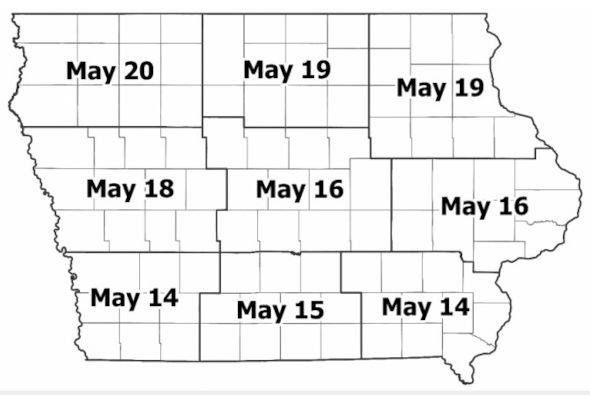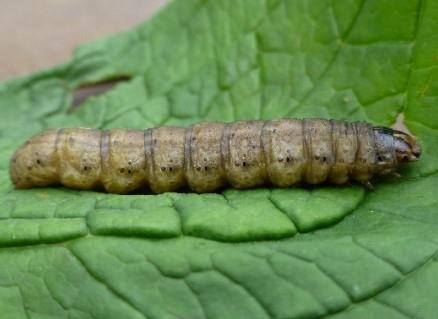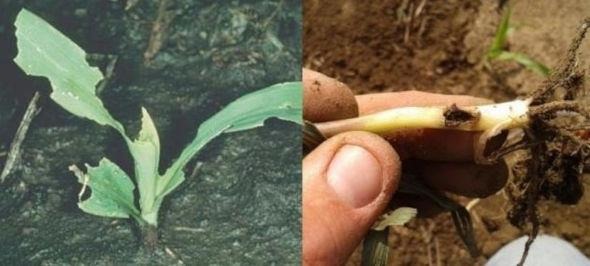By Ashley Dean and Erin Hodgson
Black cutworm (BCW) is a migratory pest that arrives in Iowa with spring storms each year. It is sporadic and unpredictable, making it essential to scout to determine whether BCW larvae are present in a field and management is required. Since much of the corn planting around the state is complete and many fields have emerged, now is a good time to begin scouting for larvae.
BCW moths lay eggs in and near crop fields, and larvae can feed on leaves or cut corn seedlings. Larvae must attain a certain size (4th instar) to be large enough to cut corn plants, and cutting can occur until plants reach the V5 stage. We can predict when black cutworm will reach the 4th instar based on accumulating degree days and when a significant flight occurred. You can read more about what a significant flight means in the Week 2 Update for the Iowa Moth Trapping Network, and an introduction to the 2021 Iowa Moth Trapping Network can be found here.
Significant flights have occurred in most areas of the state. Counties that have reported significant flights include Mahaska (April 8, 12, and 30), Benton (April 8), Carroll (April 29), Pottawattamie (April 29), O’Brien (April 8), Washington (April 9), Taylor (April 8, 18, and 26), and Monona (April 9).
Figure 1 shows the predicted cutting dates for BCW in each crop reporting district. These cutting dates are estimated by combining actual and historical GDD data. BCW trapping will continue throughout May, and any additional peak flights that occur will be included in our weekly ICM Blog updates. Keep up with the Iowa Moth Trapping Network by subscribing to the ICM Blog or checking the maps on https://corn.ipmpipe.org/insects/black-cutworm/.

Figure 1. Estimated black cutworm dates for each Iowa crop reporting district based on peak flights during April.
Capturing BCW moths in a pheromone trap does not necessarily mean there will be economic infestations in a particular location. Scouting fields is the only way to determine if BCW are present and whether management is warranted.
Identification
BCW larvae have grainy, light grey to black skin and four pairs of fleshy prolegs at the end of the abdomen (Figure 2). There are pairs of dark tubercles, or bumps, along the sides of the body. The tubercles are used to distinguish BCW from other similar cutworm species, like dingy cutworm (Figure 3), that rarely cause economic injury in corn. On each body segment, the tubercle closest to the head is about 1/3 the size of the tubercle closest to the rear for BCW; the corresponding tubercles on each segment for dingy cutworm are roughly the same size. The Field Crop Insects publication from the ISU Extension Store can aid in identification of other cutworm species.

Figure 2. Black cutworm larvae have grainy and light grey to black skin. Photo by Adam Sisson.

Figure 3. Black cutworm (left) can be distinguished from other larvae, such as dingy cutworm (right), by the dark tubercles along their bodies. For black cutworm, the tubercles nearest the head on each segment are about 1/3 the size of the tubercle closest to the rear. Corresponding tubercles on dingy cutworm are about the same size. Photos by Adam Sisson.
Scouting for black cutworm
Fields should be scouted every 7-10 days until corn reaches V5. Begin scouting several days before estimated cutting dates; early scouting is important because local larval development varies due to weather variation within a climate division, and regular scouting is important because additional flights could prolong the presence of BCW larvae in a field. BCW scouting can easily be combined with stand counts and scouting of other early-season pests.
Examine 10 corn plants in five areas of the field (50 total plants). Look for wilting, leaf discoloration or damage, and missing or cut plants (Figure 4). BCW larvae sometimes drag cut plants under soil clods to continue feeding during the day. Flag areas with suspected BCW feeding and return later to assess further injury. Take note of plant growth stage and the size of larvae in the field; this will help determine how long larvae may continue to injure plants. Larvae can be found by carefully excavating the soil around a damaged plant – BCW larvae are nocturnal feeders and will hide in the soil during the day. Remember to watch for indications of other early season pests such as wireworms, white grubs, and seedcorn maggot.
Poorly drained, low lying, or weedy areas may have a higher risk of BCW injury. Additionally, fields near perennial vegetation, fields with reduced tillage, or fields with cover crops may be at higher risk. Green cover crops are attractive to egg-laying females. Dry conditions can encourage cutting belowground, and any situation that delays emergence can contribute to cutting prior to emergence. Plants generally recover if cutting occurs above the growing point.

Figure 4. Black cutworm is known for completely severing corn seedlings. However, injury from black cutworm larvae usually begins above the soil surface. Leaf feeding can occur (left), or larvae can severely damage or kill plants (right). Photo on left copyright Marlin Rice; photo on right courtesy of Jon Kiel.
Thresholds and management
The generic economic threshold for BCW in corn is 2-3% of plants cut when larvae are less than ¾ inch long and 5% of plants cut when larvae are greater than ¾ inch long. However, this threshold can be adjusted depending on corn price, final corn stand, and input costs. A dynamic threshold calculator for BCW may be used to aid management decisions.
Preventative insecticide treatments are a questionable practice. Rescue treatments are usually the most efficient and economic approach to managing BCW since it is a sporadic pest. Scout to determine that larvae are still present in the field before spraying insecticides for BCW. Some Bt hybrids provide BCW suppression (hybrids with Vip3A and Cry1F proteins; see The Handy Bt Trait Table), but larvae can still cut young plants.
Report larvae!
If you see any fields with BCW larvae or injury while scouting, please let us know by sending a message or photo to bugtraps@iastate.edu. This information will help us refine cutting predictions and scouting recommendations in the future.
Source : iastate.edu